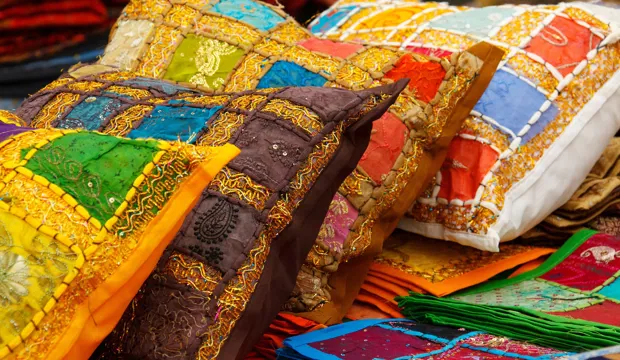
Wonderful weaving
Using wool to make a woven product
In this hands-on Islamic-inspired textiles lesson, students will use wool to make a woven product.
It's a great activity for teaching students about Islamic arts and crafts, as well as for introducing students to weaving as there is a strong tradition of weaving (and in particular carpet making) in Islamic culture. It’s also a good lesson for improving learners understanding of textile manufacturing processes.
This is one of a set of resources developed to aid the teaching of the KS3 secondary national curriculum. It has been designed to support the delivery of key topics within design and technology (DT), particularly textiles, as well as maths and science.
Activity: Using wool to make a woven product
In this weaving arts and crafts lesson, students will create their own piece of weaving using wool.
Tools/supplies needed:
- Cardboard
- Wool
- Large eye blunt needle
- Masking tape
Follow our step-by-step guide on using wool to make a woven product
Students can make a tessellated fabric print by following these steps:
- Measure and mark out slits for warp threads on the shortest edges of cardboard, 1 cm apart. Cut the slits 1cm deep into the cardboard.
- Wrap the wool around alternative slits. Stick the ends with masking tape.
- Thread the blunt needle with wool. Leave a tail when you begin weaving, going under and over.
- Change colour when the wool runs out (but leave a tail when you change colour).
- Continue weaving until you reach approximately 3 cm from the bottom of the card.
- Thread the tails into the looped ends of the weft.
- The weaving is complete!
- Turn the loom over to the front. Pull 2 adjacent warp threads from the slits and know together. Repeat with each pair of warp yarns.
- Remove the weave from the loom.
- The weaving can be displayed as a wall hanging or used to create a classroom display.
The engineering context
Weaving is used to create most fabrics used in everyday life, from clothing to wall hangings to rugs and carpets. An understanding of this textile manufacturing process is therefore essential when designing textile-based products.
Suggested learning outcomes
This lesson will teach students about weaving and specifically train them on how to use the under and over’ method to create a piece of weaving. They’ll also be able to work safely within a textiles manufacturing environment.
Download our activity sheet and other teaching resources
The activity sheet includes teachers’ notes, useful web links, and links (where appropriate) to the national curriculum in each of the four devolved nations; England, Northern Ireland, Scotland and Wales.
All activity sheets and supporting resources are free to download, and all the documents are fully editable, so you can tailor them to your students’ and your schools’ needs.
Download our weaving lesson plan and presentation below.
Please do share your highlights with us @IETeducation.




